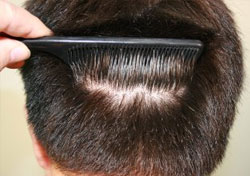After undergoing a hair transplant procedure, you do not have to deal with “hairlessness” anymore, and best of all, you no longer have to be embarrassed about your balding condition. In just a matter of time, you will be able to proudly flaunt your brand new tresses and enjoy the aesthetic benefits of getting a hair transplant. The only downside is hair transplant scarring. Due to many different reasons, people can develop scars after their hair transplant procedure, and this is one of the things that discourage people to give it a go.

Scar Revisions for Hair Transplant Scarring
To be able to repair the unfortunate hair transplant scarring, scar revisions are in order. This is the most common scar repair technique employed by various medical professionals. Here is what you should know when you are getting revisions for your hair implant scarring:
- The doctor will not excise the open donor scars if they are positioned too low. The neck muscles are quite mobile and the linear excision can stretch when the neck muscles are in active function. The scars from lower incisions have the tendency to look much worse than it should and even so much worse than the original excision.
- A typical healed open door scalp often loses mobility. This always becomes a problem when the tissues are close to the underlying fascia. When punches are accidentally created too low during hair transplantation, open donor scarring can develop.
- If the wound edges are tearing easily during suturing, the doctor will need to prepare a thinner strip to be able to decrease wound tension.
How to Avoid Hair Transplant Scarring
Is it possible to avoid the dreaded hair transplant scarring? There is much talk about the ill effects of hair transplant and knowing how to prevent them can certainly ease up your worries. Seasoned surgeons avoid creating a linear strip scar and choosing to have strip surgery is a bad decision because it almost always results to a hair transplant scarring. You may also want to discuss a technique called follicular unit extraction or FUE with your doctor. During the FUE, the follicles are removed one at a time, so it does not cause any scarring on the scalp. If you refrain from removing large portions on the scalp, scarring can be avoided. By employing the FUE technique, you not only prevent scarring, but you also take away the need for suturing.
How to Camouflage Hair Transplant Scars
When the scars cannot be removed through normal means, the next option would be to learn how to hide them. Camouflaging is a good thing to master in this case. Here are some tips to help you:
- Keep your hair long. This is the simplest way to deal with hair transplant scarring. Just make sure that the hair on the scarred part is longer, so that it does not show from the back. This is easy if you are a woman, but a bit more challenging for a man.
- You can conceal it with various cosmetic products. There is a particular product called DerMatch, which has been designed to specifically conceal scars from hair transplant surgery. Sadly, just like any cosmetic product, it could be wiped off and washed away so this is only a temporary solution.
